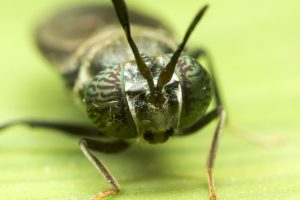With fall approaching in just weeks and schools and college dormitories opening, the Polk County Health Department is reminding everyone that bed bugs can be a big problem in college dormitories and apartments, and offering some pointers on what you can do to take care of yourself protect before you move into your new dorm or room.
Bed bugs are found in many places including homes, schools, retail establishments, office buildings, libraries and other public areas. Bed bugs are parasites that feed on humans and use the blood to grow and reproduce. Bed bugs can also feed on animals, including dogs, cats, and other pets. But make sure you have bed bugs before trying to control them. The “Let’s Beat the Bed Bug” campaign at the University of Minnesota found that 76 percent of samples submitted for identification are not bed bugs.
- Adult bed bugs are oval, flat-topped, brown, and wingless insects that are approximately 1/4″ to 3/8″ long (5-9 mm). They resemble a wood tick in appearance.
- After the beetle takes a blood meal, it changes color from brown to purplish-red and grows larger and more cigar-shaped.
- Young bed bugs are similar in shape to adults but are much smaller, 1/16″ (1.6mm) when they first hatch. Except after feeding, they are nearly colorless.
Bed bugs usually cluster in secluded areas, although some bed bugs live on their own, away from the rest of an infestation. The best way to check for an infestation is to look for bed bugs where you sleep or rest. The greatest chance of finding bed bugs is when travelling. It’s a good habit to check your room when you stay in a hotel, motel, or similar place.
While bed bugs are most commonly found in bedrooms, an infestation can also occur in other rooms, including bathrooms, living rooms, and laundry rooms.
People can be bitten without realizing it. Bite reactions vary from no reaction to mild (a red spot) to severe (rash or hives).
If you think your items may have bed bugs on them, seal everything in plastic bags until ready to wash, hand wash, heat, or freeze.
- Before leaving the place, sort everything that can be washed and put it in plastic bags.
- Separate the laundry as in normal washing of items.
- Set the washer and dryer to the hottest setting the fabric can handle.
- If you do dry cleaning services, mention that the items may contain bed bugs and that they can keep the items in the plastic bags until just before loading them into the machines.
- Examine suitcases and other items that cannot be put in a washing machine and place them in plastic bags if you find bed bugs.
- Suitcases can be hand washed with soapy water and preferably hot water.
- A temperature of 100°F to 120°F should be hot enough.
- Use a scrubbing brush along the seams and creases.
Non-washable items can be heated or frozen.
- A two-hour core exposure at 45°C (120°F) is considered the minimum target temperature for heat treatments.
- For freezing, a temperature of at least -5 °C (23 °F) must be maintained for at least five days.
- The exposure time can be reduced if the items are snap frozen at a temperature of -15°F (-26°C), which would freeze the eggs immediately.
- Most domestic freezers have temperatures between 30°F and 20°F.
- A two week freeze period is recommended if unsure of freezing temperatures.
When you heat or freeze items, these conditions must reach the core of the items being treated.
If you find anything suspicious, be sure to contact your college dorm or apartment immediately. To learn more about bed bugs and what you can do to prevent them, you can go to https://extension.umn.edu/biting-insects/bed-bugs#what-you-can-do-yourself-49011 .





